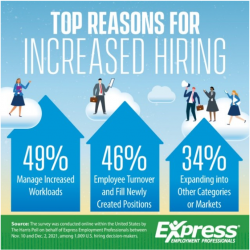 Sixty percent of companies plan to increase their number of employees in the first half of 2022 primarily due to increased workloads (49%), according to a new survey from Express Employment Professionals conducted by The Harris Poll.
Sixty percent of companies plan to increase their number of employees in the first half of 2022 primarily due to increased workloads (49%), according to a new survey from Express Employment Professionals conducted by The Harris Poll.
This is followed closely by the need to fill positions due to employee turnover (46%) and fill newly created positions (46%), while a third (34%) cite expanding into other categories or markets as the reason for their increased employee count.
However, as much as companies may long for additional employees to manage the weight of an ever-increasing workload, the ability to do so may stall this effort with nearly 3 in 5 U.S. hiring decision-makers (57%) saying they need more employees to manage their workload but do not have the capacity to hire.
A multitude of factors play into employees taking on increased duties, including turnover and increased demand for products and services.
“The numbers don’t lie,” said David Robb, co-owner and managing partner of the Grand Rapids, Michigan, Express franchise. “There just aren’t enough people available. Unless we see a big shift in the labor force participation rate, this is not going to away, and we know from long-term birthdate and retirement trends, over time, this shortage will only increase.”
While businesses across the country are grappling with this worker shortage, the lack of employees also runs the risk of burning out their current ones.
“I do see the toll this tight labor market is taking on workers, and it’s not tied to just one industry,” said Mike Brady, Express franchise owner in Jacksonville, Florida. “Employers are increasing overtime and pushing production and expectations trying to keep up with demand.”
Robb also agrees that this trend is across all industries and levels of positions.
“Just navigating life has become so much more complicated and stressful for so many people,” he said. “And on top of this, they are probably working in an environment where they may be understaffed and under more pressure than before.”
So, what can businesses do to help alleviate the higher workloads for employees?
“They need to make more quality hires, reset expectations for customers and invest in better equipment,” Brady said.
For Robb, it’s about investing in the workers companies already have so they can reduce turnover and lure top talent.
“Employers have to focus on being an employer of choice as a key strategic pillar to their success and sustainability,” he said. “Workforce planning and strategy need to be executive-level conversations. Businesses need to stand out in their community as a destination employer so that they can retain their current employees and out-compete others for new talent. This is more important than ever!”
Creating a quality company culture is a good investment, even when labor market conditions are more ideal, said Bill Stoller, CEO of Express Employment International.
“If you nurture an environment where people feel valued and motivated, the rest will follow,” he added. “It’s tough times like these where businesses should be growing, but on a foundation that can support it.”

No comments yet.